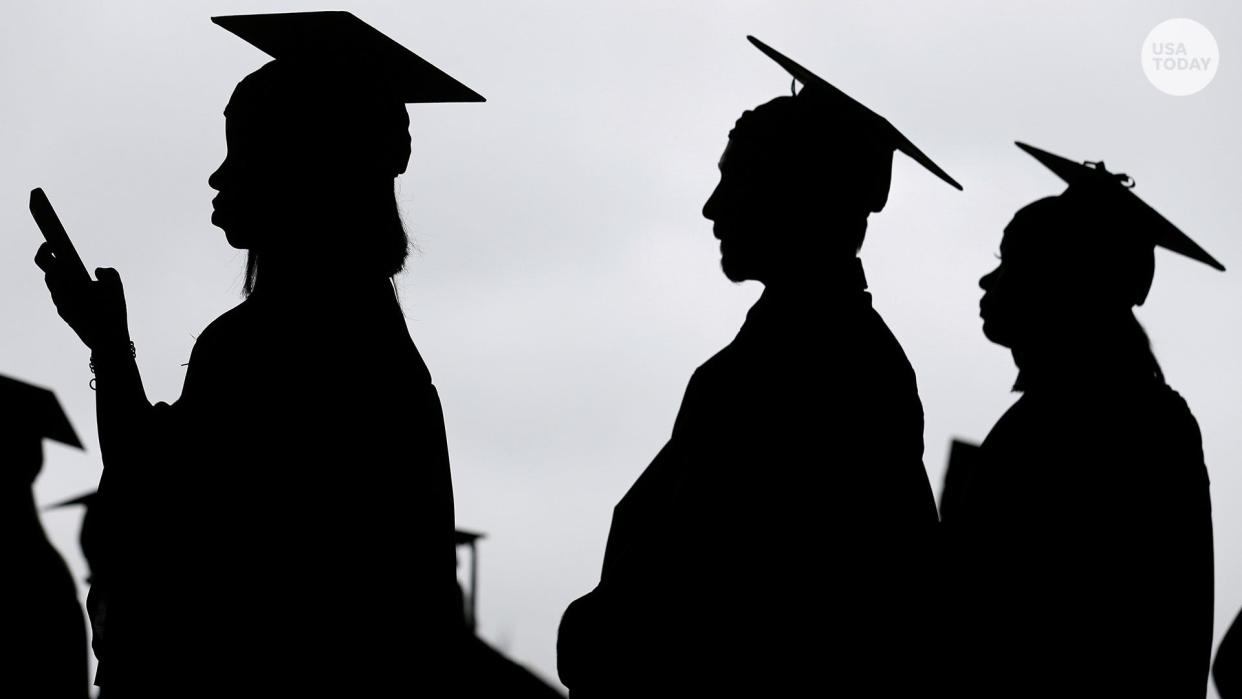Many rural and small town students skip college or go local. A new effort aims to change that

- Oops!Something went wrong.Please try again later.
First-year college student Zoie Geronimi is the only person she knows from her small town who goes to Columbia University. Geronimi, 19, went to high school in Kingsford, Michigan, where the population of about 5,000 is just a fraction of the size of New York City.
"In my area, not a lot of people pursue an education after high school, and a lot of kids go to college in my area if they do," she said on a video call from her dorm room. "I wanted to branch out, but I didn’t know where to start."
Now that she's studying computer science full time, Geronimi is helping students from her hometown and surrounding rural towns look beyond those borders through a program at her school called Take Columbia Home.
Columbia is one of 16 of the nation's top colleges and universities partnering with merchant banker Byron Trott, chairman and co-CEO of BDT & MSD Partners, to increase access to college for students from small towns and rural America.
Trott is helping launch the STARS College Network with a donation of $20 million so colleges and universities can expand efforts like Columbia's to enroll rural and small-town students, he told USA TODAY ahead of the official kickoff. STARS stands for small-town and rural students.
"There is a massive talent pool in our small towns and rural communities that has so much to offer – to our colleges, to society and to future generations," wrote Trott, who is from the small town of Union, Missouri, and attended the University of Chicago.
STEM careers less likely: For poor, rural students who lack access to advanced math courses
Rural students less likely to go to college, or complete their degrees
Students who attend rural high schools are less likely to attend and graduate from college than their peers at suburban or urban high schools, research shows.
Data from the Postsecondary National Policy Institute from 2015 shows that 18% of rural men and 20% of rural women 25 and older had a bachelor’s degree or higher compared with 32% of urban men and 33% of urban women.
And data from the National Center for Education Statistics, the Lumina Foundation notes, shows that directly after high school 59% of rural residents go on to college, compared with 62% of urban graduates and 67% of suburban grads.
The COVID-19 pandemic also depressed college enrollment.
'The bottom fell out’: For years, Latino college enrollment was on the rise. Then came the pandemic.
Challenges persist once small-town students get to college: They may feel isolated or overwhelmed on a large, bustling campus.
The goal of the STARS College Network is to get students from rural and small towns in the door at the nation's top colleges to graduation and into jobs. With the new money, the colleges will hire dedicated staff to recruit and support students from small towns and rural areas, support high school counselors and teachers, pay for students to visit their campuses, expand summer programs and help students and their families navigate financial aid.
Many colleges raised tuition for low-income students: Why did wealthier peers get more aid?
The participating colleges also said they plan to work on acclimating rural and small-town students with student groups and housing programs dedicated to them.
The colleges that benefit from STARS Network funding will then have to track student engagement, enrollment and how they support small-town and rural students, said James Nondorf, STARS co-chair and vice president of Enrollment and Student Advancement at the University of Chicago.
At Washington University in St. Louis, the number of rural students from outside Missouri who attend her institution is almost zero, said Ronné P. Turner, vice provost of admissions and financial aid.
"We're really excited about the national reach," she said.
Vanderbilt's Doug Christiansen, who is co-leading the initiative with the University of Chicago's Nondorf, said many of the colleges involved already have a commitment or desire to attract rural and small-town students.
More: One state offers lessons in how to cope with the college enrollment crisis
Some of the colleges in the network already are making headway on increasing rural student admissions.
Other colleges and universities in the STARS Network include CalTech, Colby College, Northwestern University, Ohio State, the University of Southern California and Yale.
First-gen students are missing from the nation's top colleges: Can virtual advising could help?
What gets in the way of college for small-town and rural students?
A lack of information, concerns about how to finance college and limited access to advanced coursework can all interfere with the college plans of students from small communities.
And local culture may push these students in the direction of nearby colleges and schools.
"My high school didn’t have any students going to Ivy Leagues in recent history," Geronimi said. "I was almost scared to share that this was my goal."
'I just worry that they'll be so far behind': Rural families without internet face tough choice on school
Some of those challenges double for first-generation students like Yohanna Bauerdorf, a second-year communications student at the University of Southern California. Bauerdorf, 19, said it's unlikely she would be at USC if not for financial aid.
Bauerdorf, who graduated from a high school in a small New Jersey town, said she relied heavily on social media to learn about USC, and supportive administrators, teachers and family helped get her there.
"A lot of students don’t believe they have the capability to make it to a university," she said. "The result is to not apply or think past high school."
Rural schools have a teacher shortage: Why don’t people who live there, teach there?
Contact Kayla Jimenez at kjimenez@usatoday.com. Follow her on Twitter at @kaylajjimenez.
This article originally appeared on USA TODAY: Rural students' access to elite colleges is target of new initiative

